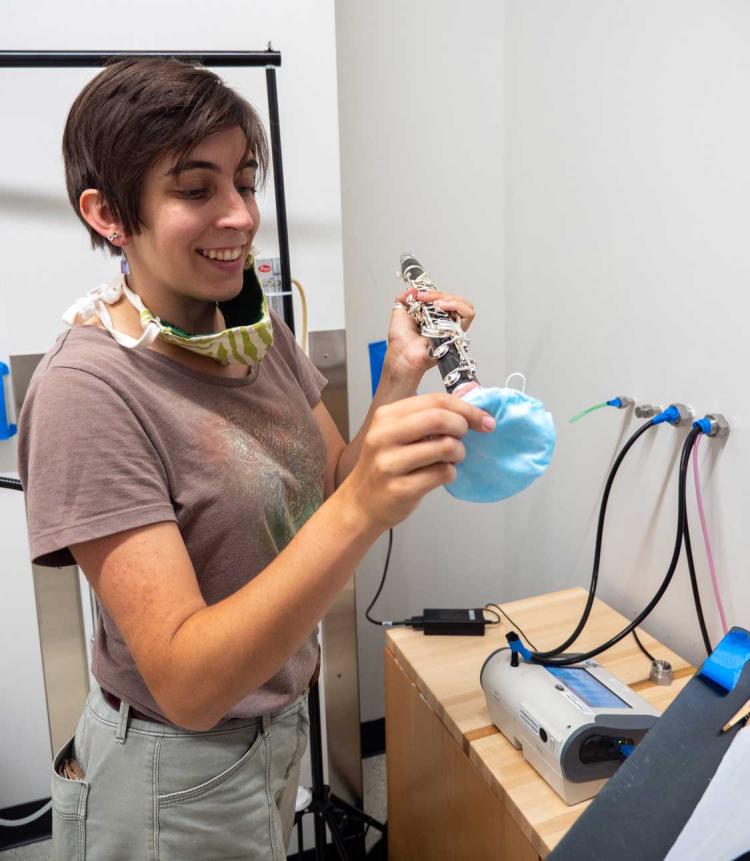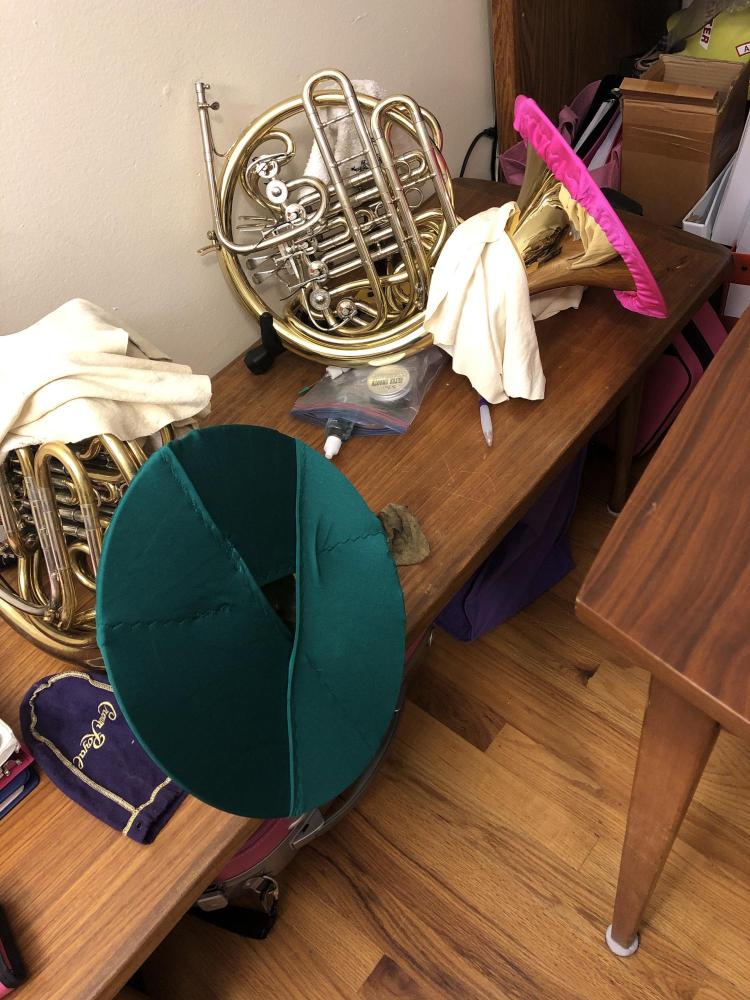Simple safety measures reduce musical COVID-19 transmission
Banner image: Music students practice safe COVID-safe protocols in Prof. Don McKinnney’s wind symphony class at the CU Boulder College of Music during the fall 2020 semester. (Credt: Glenn Asakawa / CU Boulder)
As the COVID-19 pandemic swept the globe in 2020, musicians around the world were desperate for the answers to two pressing questions: Can playing musical instruments transmit COVID-19? And if so, what can be done?
Now, halfway through 2021, the first official research results are in—and it’s good news: The show can go on.
Published today in the journal ACS Environmental Au, University of Colorado Boulder and University of Maryland researchers have found that while playing musical instruments can emit the same levels of potentially COVID-laden airborne particles as singing, simple safety measures, such as masking instruments, social distancing and implementing time limits, significantly reduce this risk.

Graduate student Tehya Stockman places a homemade bell cover made from medical mask material to test for the effectiveness of lowering aerosols in Shelly Miller's mechanical engineering laboratory on the CU Boulder campus. (Credit: Glenn Asakawa / CU Boulder)
“COVID has shown people that aerosol transmission of respiratory diseases is something that happens. But just because it goes into the air doesn't mean that everyone is going to contract this disease. We found that there are ways to mitigate these aerosols in a space and ways to reduce your risk,” said Tehya Stockman, lead author of the paper and graduate student in mechanical engineering.
This research began in earnest in 2020 at CU Boulder and the University of Maryland to find out if playing musical instruments carried the same risks of COVID-19 transmission as singing is shown to have. While there have been no reported outbreaks from instrumental ensembles, these published findings echo the researchers’ initial hypotheses and recommendations that were eagerly accepted early on in the pandemic by musicians and performing groups worldwide.
“I want to acknowledge the courage of the music directors and the teachers to go ahead and follow our suggestions in the face of all of this adversity, fear and worry,” said Shelly Miller, co-author of the study and professor of mechanical and environmental engineering. “That really meant a lot to us because they trusted our very good research methods, our researchers, and the evolution of science as it moves from: we don't know, to, let's find out, to OK—now we know this.”
These findings not only apply to the specific musical applications in which they have been tested, they also further validate that masking works as an effective mitigation technique, and ventilation and social distancing are important to reduce transmission, said Miller. Miller said she hopes these findings will further inspire a paradigm shift focused on mitigation measures and ventilation in order to reduce airborne transmission of infectious diseases.
Mitigation matters
The researchers tested three mitigation strategies on a variety of woodwind, reed and brass instruments, as well as with two singers and an actor. They evaluated these strategies, different lengths of performance time, and the differences between indoor and outdoor locations by measuring aerosols, carbon dioxide levels, and visualizing the flow of the air using various modeling techniques.
First, they found that masks work—even on instruments—and the quality of the filtering material and their fit are important. Masks worn securely over a singer’s mouth and nose, as well as bell covers (made of MERV13 filter material) placed over the ends of instruments significantly decreased the speed and amount of particles produced from both sources.
For woodwind and reed instruments, they found that the amount of air that escapes from the keyholes does not significantly contribute to any increased risk. This means that clarinetists and flautists do not have to place a bag around their entire instrument to play safely.
Second, time together matters. To keep risk low (at 10% chance of transmission), instrumentalists should spend less than 30 minutes indoors and less than 60 minutes outdoors playing together at a time. No matter the amount of social distancing, “infection risk continuously increases with the duration regardless of the distance to the singer or the player,” the researchers found.
They also found that spacing out does pay off: Leaving several feet of distance between players and singers reduces aerosol concentrations, which are highest closest to each person producing them. And while playing outdoors is best, a layered approach with all the other mitigation measures makes it much safer to play indoors.
Finally, no Plexiglass or face shields are needed. The airborne particles that transmit COVID-19 can easily flow around these barriers and mix with the air in a room.
Quantifying carbon dioxide

Maddie Levinson, a CU Boulder graduate, started sewing COVID-friendly French horn covers for school band programs across the state in 2020. Published research now confirms that using bell covers made of high quality, MERV13 filter material significantly decreases the speed and amount of potentially COVID-laden particles produced from music instruments. (Credit: Maddie Levinson)
So how then, can a musician or audience member now know it’s safe to attend a concert?
Carbon dioxide has been shown to be great indicator of how well ventilated—or not—an indoor space is, and therefore its level of risk for catching COVID-19.
But in this study, the researchers showed that when somebody wears a mask, carbon dioxide passes through the mask with the air that a person is exhaling, but the particles which can carry the virus get stuck. This means that when someone puts on a mask or a bell cover, the carbon dioxide emissions continue, but the particle emissions (which could carry the virus) are reduced.
“Carbon dioxide concentration is a measure of the ventilation in the room. But if everybody's wearing a mask, the carbon dioxide in that room is still going to be high, but the respiratory droplets that may contain the virus are going to be much lower,” Marina Vance, co-author on the study and assistant professor in the Department of Mechanical Engineering and the Environmental Engineering Program. “So in that case, it’s not a direct representation of your risk.”
So, if a concert hall requires all audience members to wear masks and that all performers place a bell cover on their instrument, the risk of COVID transmission in that room would be reduced—even if the measured carbon dioxide levels are high. But carbon dioxide is still a great proxy for risk indoors in restaurants, where most people are not masked and are often speaking loudly.
Such direct application of this research to real-life scenarios has been an extremely rewarding experience for Vance and the other researchers.
“The best part of the study was that all of this technical knowledge and all of this scientific understanding was getting translated almost in real-time and getting into the hands of the people that needed it the most. I've never been a part of anything like that,” said Vance. “It was nerve-wracking, exciting and important all at once.”
The safe return of music
When lead author Stockman first learned to play clarinet years ago, she didn’t do so with the intent to advance scientific research. But her personal musical experience allowed the work to advance quickly, as she performed calibration tests by herself in the lab during the pandemic.
She understands the frustrations of musicians who may need to follow these protocols. She also knows how important it is to keep people safe.
“What we've shown is that there's easy measures to take that make life still be relatively normal—and you don't have to fear the air,” said Stockman.
This sentiment is echoed by co-authors Mark Spede, National President of the College Band Directors National Association and Director of Bands at Clemson University, and James Weaver, Director of Performing Arts and Sports for the National Federation of State High School Associations, who point out that the mitigation strategies tested in this study can be implemented not only during the lingering COVID-19 pandemic, but in the face of any future pathogen that may come along.
“Although we may not know how the end of the pandemic will play out, this important study has allowed performing arts educators to advocate for the safe return of live music to the classroom,” said Spede.
This research was conducted in partnership and collaboration with the National Federation of State High School Associations and College Band Directors National Association.
Additional authors on this publication include: Abhishek Kumar, Lingzhe Wang, Sameer Patel, Darin Toohey and Jean Hertzberg of CU Boulder; and Shengwei Zhu, Don Milton and Jelena Srebric of the University of Maryland.


